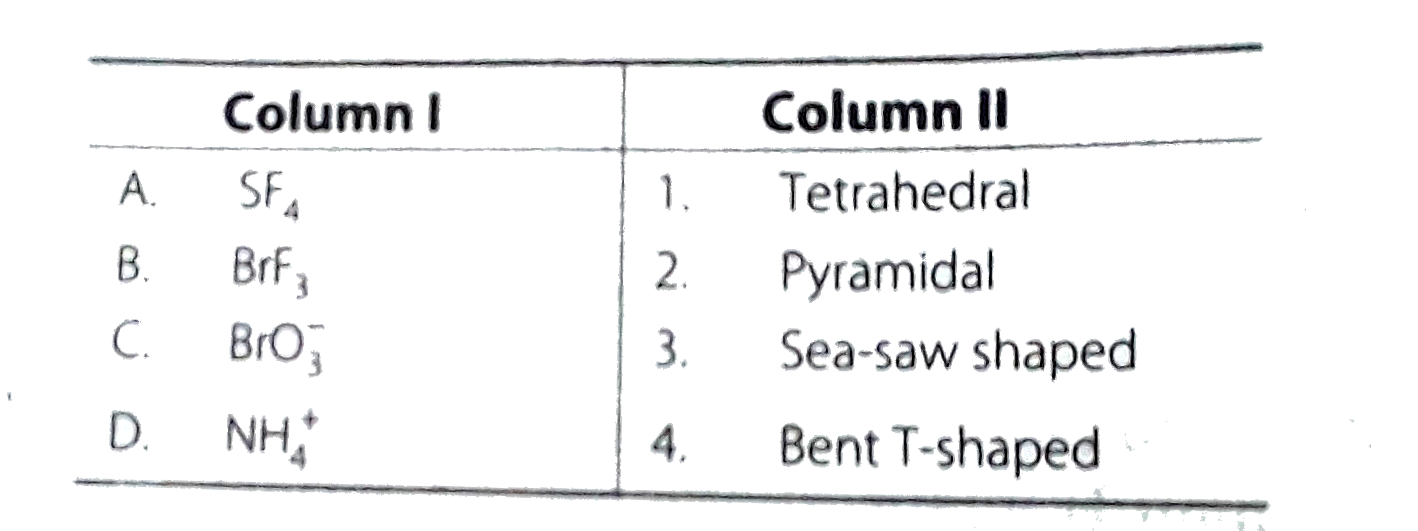Match the species given in Column I with the properties mentioned in Column II
To solve the matching question, we will analyze each species in Column I and determine their corresponding properties in Column II step by step.
Step 1: Analyze BF₄⁻
- Species: BF₄⁻
- Valence Electrons: Boron (B) has 3 valence electrons, and there are 4 fluorine (F) atoms, each contributing 1 electron. Since it is an anion (negative charge), we add 1 electron.
- Calculation:
- Total valence electrons = 3 (B) + 4 (F) + 1 (charge) = 8
- Hybridization = (8 / 2) = 4 (indicating sp³ hybridization).
- Shape: Tetrahedral.
- Match: A matches with 5 (Tetrahedral shape).
Step 2: Analyze AlCl₃
- Species: AlCl₃
- Valence Electrons: Aluminum (Al) has 3 valence electrons and is bonded to 3 chlorine (Cl) atoms.
- Electron Deficiency: Al has only 6 electrons in its valence shell after bonding, which means it has an incomplete octet and can accept electrons.
- Lewis Acid: This property makes AlCl₃ a Lewis acid.
- Match: B matches with 3 (Lewis acid).
Step 3: Analyze SnO
- Species: SnO
- Oxidation States: Tin (Sn) can have oxidation states of +2 and +4. In SnO, Sn is in the +2 oxidation state.
- Further Oxidation: Since Sn can exist in a +4 state, SnO can be further oxidized to SnO₂.
- Match: C matches with 4 (Can be further oxidised).
Step 4: Analyze PbO₂
- Species: PbO₂
- Oxidation State: Lead (Pb) in PbO₂ has an oxidation state of +4.
- Strong Oxidizing Agent: PbO₂ can act as a strong oxidizing agent because it can be reduced to Pb²⁺, which is more stable due to the inert pair effect.
- Match: D matches with 1 (Oxidation state of central atom is +4) and also with 2 (Strong oxidising agent).
Final Matches:
- A → 5 (Tetrahedral shape)
- B → 3 (Lewis acid)
- C → 4 (Can be further oxidised)
- D → 1 (Oxidation state of central atom is +4) and 2 (Strong oxidising agent)
Summary of Matches:
- A → 5
- B → 3
- C → 4
- D → 1 and 2
- Species: BF₄⁻
- Valence Electrons: Boron (B) has 3 valence electrons, and there are 4 fluorine (F) atoms, each contributing 1 electron. Since it is an anion (negative charge), we add 1 electron.
- Calculation:
- Total valence electrons = 3 (B) + 4 (F) + 1 (charge) = 8
- Hybridization = (8 / 2) = 4 (indicating sp³ hybridization).
- Shape: Tetrahedral.
- Match: A matches with 5 (Tetrahedral shape).
- Species: AlCl₃
- Valence Electrons: Aluminum (Al) has 3 valence electrons and is bonded to 3 chlorine (Cl) atoms.
- Electron Deficiency: Al has only 6 electrons in its valence shell after bonding, which means it has an incomplete octet and can accept electrons.
- Lewis Acid: This property makes AlCl₃ a Lewis acid.
- Match: B matches with 3 (Lewis acid).
- Species: SnO
- Oxidation States: Tin (Sn) can have oxidation states of +2 and +4. In SnO, Sn is in the +2 oxidation state.
- Further Oxidation: Since Sn can exist in a +4 state, SnO can be further oxidized to SnO₂.
- Match: C matches with 4 (Can be further oxidised).
- Species: PbO₂
- Oxidation State: Lead (Pb) in PbO₂ has an oxidation state of +4.
- Strong Oxidizing Agent: PbO₂ can act as a strong oxidizing agent because it can be reduced to Pb²⁺, which is more stable due to the inert pair effect.
- Match: D matches with 1 (Oxidation state of central atom is +4) and also with 2 (Strong oxidising agent).
- A → 5 (Tetrahedral shape)
- B → 3 (Lewis acid)
- C → 4 (Can be further oxidised)
- D → 1 (Oxidation state of central atom is +4) and 2 (Strong oxidising agent)
- A → 5
- B → 3
- C → 4
- D → 1 and 2
Topper's Solved these Questions
- BOOK - NCERT EXEMPLAR ENGLISHCHAPTER - THE P-BLOCK ELEMENTSEXERCISE - Assertion and Reason2videos
THE P-BLOCK ELEMENTS
- BOOK - NCERT EXEMPLAR ENGLISHCHAPTER - THE P-BLOCK ELEMENTSEXERCISE - Long Answer9videos
THE P-BLOCK ELEMENTS
- BOOK - NCERT EXEMPLAR ENGLISHCHAPTER - THE P-BLOCK ELEMENTSEXERCISE - Short Answer14videos
THE P-BLOCK ELEMENTS
- BOOK - NCERT EXEMPLAR ENGLISHCHAPTER - STRUCTURE OF ATOMEXERCISE - All Questions55videos
STRUCTURE OF ATOM
- BOOK - NCERT EXEMPLAR ENGLISHCHAPTER - THE S-BLOCK ELEMENTS EXERCISE - Long Answer Type Questions8videos
THE S-BLOCK ELEMENTS
Similar Questions
Match the statements given in Column I with the oxidation states given in Column II.
 View Solution
View SolutionMatch the species given in Column I with the shape given in Column II and mark the correct option.
 View Solution
View SolutionMatch the species given in Column I with properties given in Column II
Column-IColumn-IIA.Diborane1.Used as a flux for soldering metalsB.Gallium2.Crystalline form of silicaC.Borax3.Banana bondsD.Aluminossilicate4.Low melting, high boiling, useful for measuring high temperaturesE.Quartz5.Used as catalyst in petrochemical industriesView SolutionMatch the types of colloidal systems given in Column I with the name given in Column II.
Column IColumn IIA.Solid in liquid1.FoamB.Liquid in solid 2.SolC.Liquid in liquid 3.GelD.Gas in liquid4.EmulsionView SolutionMatch the elements given in Column I with the properties mentioned in Column II.
ColumnIColumnIIA.Li1.Insoluble sulphateB.Na2.Strongest monoacidic baseC.Ca3.Most negativeEΘvalue among alkali metalsD.Ba4.Insoluble oxalate5.6s2outer electronic configurationView SolutionMatch the species given in Column I with hybridisation given in Column II.
Column-IColumn-IIA.Boron in[B(OH4)]−1.sp2B.Aluminium in[Al(H2O)6]3+2.sp3C.Boron in B2H63.sp3d2D.Carbon in buckminster fullereneE.Silicon in SiO4−4F.Germanium in[GeCl6]2−View SolutionMatch the elements given in column (I) with the most appropriate expected values given in column (II)
Column IColumn IIElementElectronegative valuesA.F(p)3.5B.O(q)3.0C.N(r)4.0D.C(s)2.5View SolutionMatch the terms in column I with those in column II .
Column IColumn IIA.TrypsinPancreasB.AmylaseLiverC.BileGastric glandsD.PepsinSalivaView SolutionMatch Column I with Column II for the given properties/ applications mentioned therein.
 View Solution
View SolutionMatch the shape of molecules in Column 1 with the type of hybridisation in Column II.
Column IColumn II(a)Tetrahedral(i)sp2(b)Trigonal(ii)sp(c)Linear(iii)sp3(d)Trigonal bipyramidal(iv)sp3dView Solution

